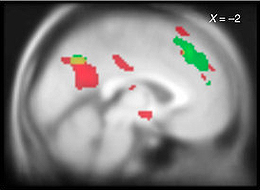Research Abstract
犯罪者に対して情状酌量する際に活性化する脳内神経回路
Neural circuits in the brain that are activated when mitigating criminal sentences
2012年3月27日 Nature Communications 3 : 759 doi: 10.1038/ncomms1757

裁判において犯罪者の量刑を決定するにあたり、犯罪者の同情的事情を酌んで情状酌量を判断する場合がある。今回の研究では、法律的判断の訓練を受けていない一般人が、模擬裁判で量刑判断する際の神経活動を、機能的磁気共鳴画像法を用いて測定した。その結果、同情判断によって他者理解や道徳的葛藤とかかわる脳領域(前頭前皮質背内側部、楔前部、側頭頭頂接合部)の活動が高まることがわかった。量刑判断によっても楔前部と前帯状皮質の活動が同様に高まることから、減刑判断は、犯罪に対する不快情動反応、被告人への同情、および量刑判断という認知制御がかかわっていることが示唆される。同情をどの程度減刑に還元するかという情状酌量傾向における個人差は、身体内部状態の情報を表象する右側島皮質の活動と相関していた。これらの結果は、裁判員がどのように法的判断を行うかについての脳科学的知見を提供するものであり、また、情動と認知がいかに融合されて複雑な意志決定を行うのかについての理論的発展につながるだろう。
- 独立行政法人 放射線医学総合研究所 分子イメージング研究センター 分子神経イメージング研究グループ
- 独立行政法人 科学技術振興機構(JST)戦略的創造研究推進事業さきがけ
- カリフォルニア工科大学(米国)
- 慶應義塾大学 医学部 精神・神経科学教室
- 玉川大学 脳科学研究所
- 京都大学 医学部 精神医学教室
In sentencing guilty defendants, jurors and judges weigh 'mitigating circumstances', which create sympathy for a defendant. Here we use functional magnetic resonance imaging to measure neural activity in ordinary citizens who are potential jurors, as they decide on mitigation of punishment for murder. We found that sympathy activated regions associated with mentalising and moral conflict (dorsomedial prefrontal cortex, precuneus and temporo-parietal junction). Sentencing also activated precuneus and anterior cingulate cortex, suggesting that mitigation is based on negative affective responses to murder, sympathy for mitigating circumstances and cognitive control to choose numerical punishments. Individual differences on the inclination to mitigate, the sentence reduction per unit of judged sympathy, correlated with activity in the right middle insula, an area known to represent interoception of visceral states. These results could help the legal system understand how potential jurors actually decide, and contribute to growing knowledge about whether emotion and cognition are integrated sensibly in difficult judgments.

